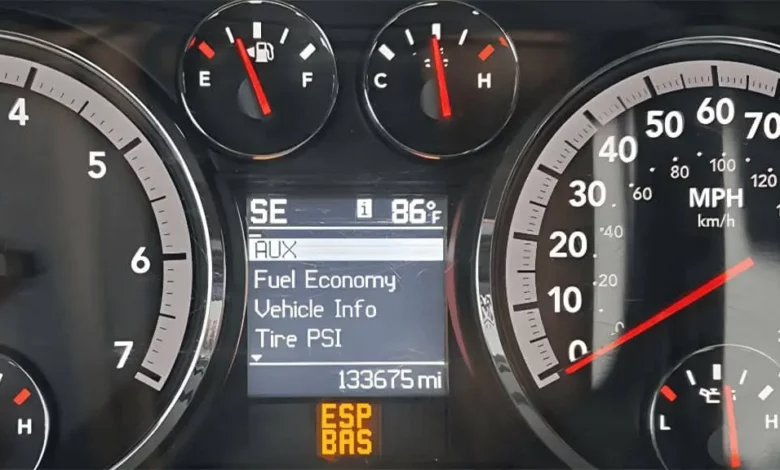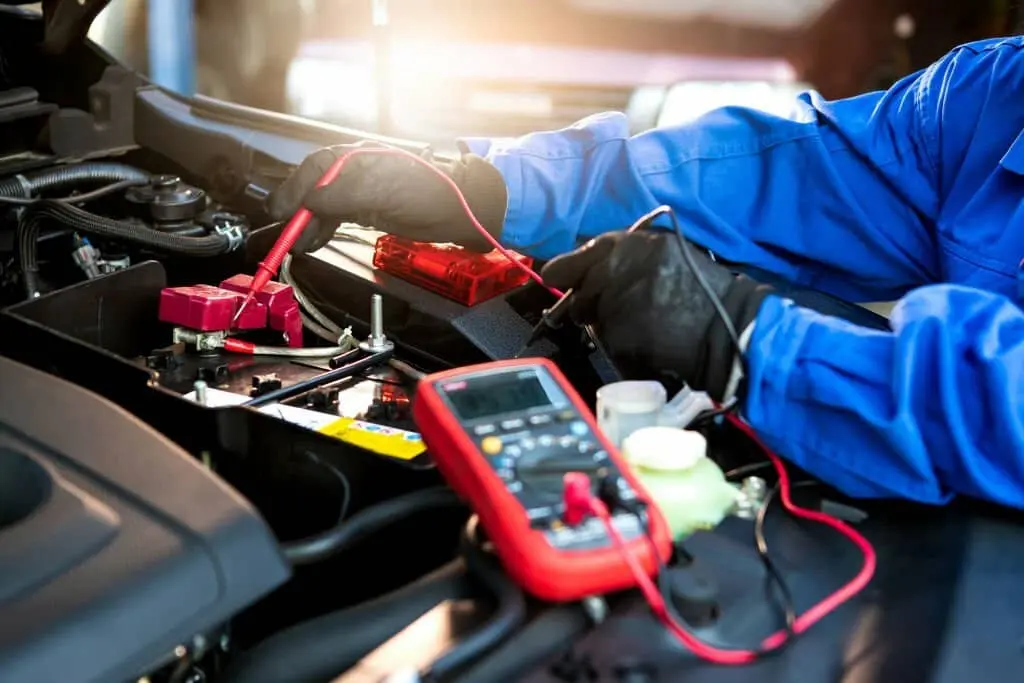ESP BAS Light: 5 Essential Insights for Empowered and Safe Jeep Driving

Table of Contents
Picture this: You’re driving in your Jeep, facing difficult terrain with the confidence of a seasoned explorer. But then a little light flickers on your panel—the ESP BAS light. For many Jeep fans, this light can be a source of misunderstanding. What does it mean, and how does it affect your driving experience? Fear not, fellow off-road heroes! In this thorough guide, we’ll explain the secrets of the ESP BAS light in your Jeep, ensuring you’re equipped with all the information you need for a safe and fun ride. Let’s dive into the world of Jeep’s advanced safety features and understand why keeping an eye on your ESP BAS light is crucial for your exciting trips.
What is ESP BAS Light?
Understanding ESP: The Stability Guardian
- Electronic Stability Program (ESP): Begin by describing ESP, a critical safety feature in modern cars, especially in Jeeps known for their off-road skills. ESP helps keep control during difficult driving situations. It identifies and lowers loss of traction (skidding) using sensors to track car movements and driving input.
- ESP in Action: Illustrate with an example, such as how ESP intervenes during a slippery road scenario. It provides brakes for individual wheels and lowers engine power to help the driver keep control. Stress the value of ESP in avoiding crashes, especially in Jeeps that often cross rough territory.
The Role of BAS: Instant Aid in Critical Moments
- Brake Assist System (BAS): After describing ESP, present BAS. This device helps the driver during emergency stops by boosting braking power. It’s meant to ensure the car gets maximum stopping efficiency over a shorter distance.
- BAS at Work: Describe a situation, like an unexpected obstacle on an off-road trail, where BAS kicks in to provide the necessary extra stopping power. This is particularly useful in Jeeps, where quick reactions are often needed on difficult terrain.
ESP BAS Light: The Indicator of Safety Systems at Work
- Interconnected Safety: Highlight that the ESP BAS light on the Jeep’s dashboard is a sign that represents the state of these two important systems. Explain that when everything is working right, this light is usually off. However, when it lights up, it’s a warning to the driver that there may be a problem with the ESP, BAS, or both.
- Light Behaviors: Differentiate between the light being constantly on and it changing. A steady light might indicate a possible problem or failure, while flashing could mean the ESP is actively working to balance the car.
The importance of ESP and BAS in Jeep vehicles
- Enhanced Safety on Rugged Terrains: Conclude by stressing the importance of ESP and BAS in Jeeps. These vehicles are often used in situations where handling and stopping can be tested, like off-roading, uneven roads, and slippery conditions. The ESP BAS light serves as a crucial communication tool between the vehicle’s safety systems and the driver, ensuring a better driving experience.
Section 2: Decoding the ESP BAS Light in Your Jeep
The Meaning Behind the Light
- An Indicator, Not Just a Warning: Begin by explaining that the ESP BAS light on the dashboard is not just a danger signal but an important measure of the vehicle’s health, especially regarding its stability and braking systems. It’s crucial for Jeep drivers to understand what the light indicates to ensure their vehicle is always in top shape for difficult drives.
- Light Illumination: Explain that when the ESP BAS light stays lit, it indicates a possible problem with the Electronic Stability Program, Brake Assist System, or possibly both. This could be due to various reasons, ranging from small problems to more major system failures.
Common Triggers for ESP BAS Light Activation
- Sensor Issues: Discuss how problems with the wheel speed sensors, steering angle sensor, or brake pressure sensors can cause the ESP BAS light. These devices are important for the proper working of the ESP and BAS, and any failure can risk car control.
- Electrical Glitches: Mention that electrical issues, such as a weak battery or bad wires, can also lead to the light going on. In Jeeps, which often go through rough territory and difficult circumstances, electrical cables can become loose or broken.
- Software Malfunctions: Sometimes, the reason might be linked to the vehicle’s computer system. A program glitch or the need for an update can result in the ESP BAS light going on.
Basic Troubleshooting Steps

- Initial Checks: Advise readers to start with basic checks, like ensuring the battery is fully charged and the links are safe. They should also check the state of sensors and wires, looking for any clear signs of damage or separation.
- Resetting the Light: Offer an easy tip to reset the light by turning the steering wheel to the extreme left, then to the extreme right, and finally back to the center. This recalibration can sometimes fix the problem if it’s sensor-related.
- When to Seek Professional Help: Emphasize the value of professional diagnosis if the light continues. Given the technical nature of the ESP and BAS systems, a trained mechanic should check the car to find and fix any underlying issues.
ESP BAS Light Meaning: A Deeper Dive
Anatomy of the ESP BAS System
- Sensors Galore: Start by describing the various sensors involved in the ESP BAS system. Wheel speed sensors, turning angle sensors, and stop pressure monitors are key. Each sensor plays a crucial role in tracking car physics, from how fast the wheels are moving to the position of the steering wheel and the pressure put on the brakes.
- The Control Unit: Explain the key role of the Electronic Control Unit (ECU) in the ESP BAS system. It’s the brain of the operation, handling data from the sensors to identify if the car is losing control or if there’s insufficient stop power.
How ESP and BAS Interact
- Maintaining Stability: Dive into how the ESP part works. When it detects a loss of driving control, ESP automatically uses the brakes to help “steer” the car where the driver wants to go. Braking is instantly given to individual wheels—for example, the outer front wheel to counter oversteer or the inner back wheel to counter understeer.
- Enhancing Brake Performance: Detail how BAS supports ESP. In an emergency, if the driver uses the brakes quickly but not strongly enough, BAS increases the brake force to the highest amount to stop the car more effectively.
Triggers for the ESP BAS Light
- Malfunctioning Sensors: Discuss how broken or dirty sensors can send wrong messages to the ECU, leading to the ESP BAS light going on. This is common in off-roading settings where sensors can get covered in mud or debris.
- Electrical System Issues: Elaborate on how problems with the vehicle’s electrical system, like a weak battery or damaged connections, can affect the performance of the ESP BAS system, causing the warning light.
- Software and Calibration Issues: Mention that software problems or the need for recalibration can also lead to the ESP BAS light lighting. Sometimes, after changing parts or tires, the system may need recalibration to work properly.
The Importance of Timely Attention
- Safety First: Conclude by emphasizing the importance of handling any problems suggested by the ESP BAS light quickly. Ignoring the light can lead to reduced performance of critical safety features, which is especially important in a vehicle like a Jeep, often used in difficult driving conditions.
DIY Tips: Handling the ESP BAS Light
Initial Self-Diagnosis

- eye check: Encourage Jeep drivers to start with an eye check. Check for any clear signs of damage to the wheels, brakes, and sensors. Look for weak links or any obvious wear and tear that could affect the vehicle’s balancing systems.
- Battery Check: Since a weak battery can often trigger the ESP BAS light, suggest checking the battery’s health. This includes ensuring the links are clean, tight, and free from rust.
Simple Fixes at Home
- Sensor Cleaning: Dirt and dirt can interfere with the sensors’ working. Guide users on how to find and gently clean the wheel speed sensors and steering angle sensors using suitable tools and methods.
- Steering Angle Sensor Calibration: Offer a step-by-step guide on recalibrating the steering angle sensor. This can often be done by starting the engine, moving the steering wheel all the way to the left, then all the way to the right, and finally back to the center position.
Regular maintenance tips
- Brake System Repair: Stress the value of annual brake repair. This includes checking brake pads and discs for wear and tear, ensuring the brake fluid is at the right amount, and changing it as per the manufacturer’s suggestions.
- Tire Health: Remind readers that uneven or worn-out tires can affect the vehicle’s handling, possibly causing the ESP BAS light. Check the tread depth and tire pressure frequently.
Knowing when to consult a professional
- Persistent Warning Light: If the ESP BAS light stays on after trying the above steps, it’s time to seek professional help. A continuous light could signal a more serious problem that requires testing tools and knowledge.
- Complex Electrical Issues: Highlight that electrical issues beyond basic battery upkeep are best handled by pros. This includes dealing with any hardware problems or program issues in the ESP BAS system.
- Safety as a Priority: Finally, stress that while some problems can be handled at home, the safety systems of a car are important. If there’s any question or lack of trust in handling the problem, it’s always safer to call a professional mechanic.
The Bigger Picture: ESP BAS and Vehicle Safety
Understanding vehicle safety systems

- Beyond ESP and BAS: Start by widening the topic beyond ESP and BAS. Explain how these systems are part of a bigger network of safety features in modern cars, including airbags, traction control, and anti-lock braking systems (ABS).
- Integrated Safety Approach: Emphasize that car safety is about the merging of multiple systems acting in harmony. The ESP BAS system, in combination with other safety features, ensures the car reacts successfully to a variety of driving situations and incidents.
The Evolution of Vehicle Safety
- Historical Perspective: Provide a quick history of how car safety features have changed over the years. Highlight key events, such as the adoption of seat belts, airbags, and more advanced computer systems like ESP.
- technical developments: Discuss the technical developments that have made features like ESP and BAS more effective. This includes the creation of more accurate devices, improved computer power in cars, and the use of AI and machine learning in newer models.
ESP BAS in the Context of Modern Driving
- Current Trends: Acknowledge current trends in driving and vehicle technology. For instance, the rise of electric cars and automatic driving technologies is affecting the development of safety systems.
- Jeep and Off-Road Safety: Particularly for Jeep and other off-road cars, look into how the ESP BAS system is designed for difficult terrains and circumstances. This might include changes for higher-ground-clearance cars or the ability to handle changing driving situations.
The Future of Vehicle Safety Technologies
- Predictive Safety Features: Discuss new safety features that go beyond reaction systems like ESP and BAS. Talk about predictive technologies that anticipate possible dangers and change car dynamics proactively.
- Integration with automated driving: Touch upon how ESP and BAS might develop with the growth of automated driving. Explore how these systems might be combined into self-driving programs to improve safety further.
The role of the driver in vehicle safety
- Human Element: Conclude by telling readers that despite improved safety features, the driver’s part remains important. Responsible driving, knowledge of car capabilities, and understanding of safety systems like ESP BAS are essential for safety on the road.
Conclusion: Embracing Safety and Technology with the ESP BAS Light
Summarizing the ESP BAS Light’s Role
- A Beacon of Safety: Begin by summarizing the role of the ESP BAS light as not just an indicator but a guardian of safety in your Jeep. It’s a sophisticated system that constantly monitors and responds to driving conditions, ensuring stability and optimal braking performance.
- Vital for Off-Road Adventures: Emphasize the particular value of ESP and BAS in Jeeps, cars often used in difficult terrain. The light serves as a crucial guide, helping drivers maintain control and safety in different off-road scenarios.
Reflecting on Key Insights
- Understanding the Mechanics: Recap the importance of understanding the mechanics behind the ESP BAS system. Knowledge of how sensors, control units, and integrated safety systems work provides drivers with the insights needed to identify potential issues indicated by the light.
- DIY Maintenance and When to Seek Help: Highlight the balance between DIY maintenance and knowing when to seek professional help. While some issues can be addressed through simple checks and fixes, more complex problems require the expertise of a professional mechanic.
The Broader Context of Vehicle Safety
- Technological Evolution: Reflect on the evolution of vehicle safety systems and how ESP and BAS fit into this larger picture. The integration of these systems with other safety features represents technological advancements in automotive safety.
- Looking Forward: Touch upon the future of vehicle safety, with ESP BAS systems becoming more sophisticated and potentially integrating with autonomous driving technologies. This evolution signifies a promising future for vehicle safety and reliability.
Emphasizing Driver Responsibility
- The Human Factor: Conclude with a strong reminder of the driver’s role in vehicle safety. While technology like the ESP BAS light provides essential assistance, responsible driving and awareness of one’s vehicle’s capabilities remain key to ensuring safety on the road.
- A Commitment to Safe Driving: Encourage readers to view the ESP BAS light not as a mere technicality but as part of their commitment to safe driving. Understanding and responding to this light is part of being a responsible Jeep owner, dedicated to enjoying the adventurous spirit of their vehicle while prioritizing safety.

